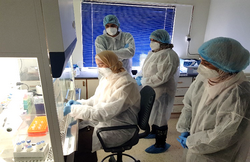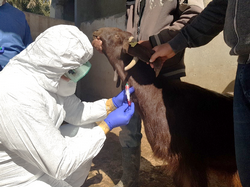Good biosecurity practice for zoonotic agents
Introduction
The Biosecurity Engagement Program (BEP) was first funded in FY 2006 and is part of the Nonproliferation, Anti-Terrorism, Demining and Related Programs Global Threat Reduction programs account managed and implemented by the U.S. Department of State Bureau of International Security and Nonproliferation Office of Cooperative Threat Reduction (ISN/CTR).
The BEP mission is to engage life scientists and to combat biological threats worldwide by providing assistance to improve biosecurity, biosafety, pathogen surveillance, and infectious disease surveillance and response. In fulfilling its mission, BEP seeks to guide its efforts based on the National Strategy for Countering Biological Threats (PPD-2), which builds upon the National Biodefense Strategy (HSPD-10/NSPD-33), as well as international guidance from the Biological and Toxin Weapons Convention and United Nations Security Council Resolution 1540.
Since 2006, BEP has expanded its scope of work, countries of engagement, and funding commitment. In every country in which BEP is engaged, the long-term goal of our programmatic activities is to work with governments and other stakeholders to build sustainable capacity for biosecurity, biosafety, disease surveillance, and scientific inquiry. To assess our success, we are working with collaborators to develop metrics that will enable assessment of not only the nature and extent of our engagement, but also the sustainability of the programs and capacities that we are introducing.
As a component of the BEP, the "Good biosecurity practice for zoonotic agents" project is implemented by VetEffecT, in association with Animal Health Works.

In the MENA region (Egypt, Jordan, Libya, Tunesia, Algeria) as well as in Central Asia (Pakistan, Afghanistan) most of the veterinary field work is executed by veterinary para-professionals or veterinary technicians with limited training and understanding of biosecurity and zoonotic threats. Their training and main focus of work is on treatment of diseased livestock with a limited array of diagnostic tools.
However, a number of zoonotic diseases such as Anthrax, Brucella, Crimean-CongoHemorrhagic Fever and Q-fever are still common, exposing livestock owners and villagers to these threats.
The role of veterinary para-professionals extends beyond these private veterinary services as they also act as first in line with regards to animal disease surveillance. Unfortunately, their training and awareness of this role is limited.
For most of the regional and national laboratories, awareness and means to handle samples of these infections are insufficiently available. This has to do with the relative low number of samples being received from the field and limited awareness to the risk of these infections. Subsequently, few samples are forwarded to international (FAO/OIE) reference laboratories for further confirmation and genotyping. As a result, limited information about the occurrence and dynamics of these zoonotic threats is available at global level.
The project aims to improve the diagnostic capacity and reduce risks of zoonotic diseases in these countries offering a sustainable training environment.
Approach
As part of the Biosecurity practices project, biosecure sampling of livestock and sample submission of hazardous animal infections is strengthened and institutionalized from field to national reference laboratory, and, as applicable, submission to international reference laboratories in different target countries by targeted training of trainers in a sustainable and blended training approach.
The focus of this project is on hazardous zoonotic diseases such as Anthrax, Brucella, Rabies, Crimean Congo Hemorrhagic Fever (CCHF), Q-fever and highly pathogenic avian influenza (HPAI) H5N1.
The target groups are veterinary and laboratory staff from national and regional institutions, involved in biosecure sampling of livestock and sample submission of hazardous animal infections.

The training consists of blended learning: e-learning and coaching, and live trainings as classroom trainings, interactive workshops, laboratory demonstrations, and field demonstrations and exercises. At the national reference laboratory, staff is trained to handle, test, archive and forward relevant samples to international reference laboratories. In addition, staff is trained to instruct regional specialists in animal disease surveillance how to sample animals suspected of hazardous diseases in the field, and how to submit these samples of hazardous animal infections in a standardized manner respecting the basic principles of biosecurity to national reference labs.
The training consists of e-learning and live trainings at national (central) level in a first tier, and at regional level, in a second tier. In the first tier, international experts train veterinary and laboratory staff from national institutions on the selected hazardous zoonotic diseases and on training methodologies to develop skills to train their peers at regional level. To extend the reach of this project, cascade training (second tier) is incorporated using the train-the-trainer model. In the second tier, staff from the national level and trained in the first tier is training veterinary and laboratory staff from regional institutions to extend the reach of this project to a larger number of veterinary para-professionals and laboratory staff in the regions.
Following this train-the-trainer approach, the project delivers in each country several experts equipped with skills and materials to conduct similar trainings in the country to reach all relevant staff from regional laboratories in their native language.
